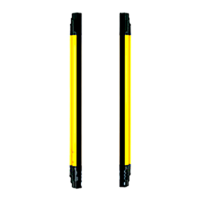
Do you have a question about the Pilz PSEN op4F-A Series and is the answer not in the manual?
| Operating voltage | 24 V DC |
|---|---|
| Housing material | Plastic |
| Safety category | Category 4 |
| IP Rating | IP67 |
| Safety level | PL e |
Describes the PSEN op4F/H-A series as multibeam active optoelectronic protective devices.
Explains resolution, protected field height, and minimum safety distance for selection.
Provides essential information for the safe and correct use of safety light curtains.
Lists precautions for safety level, OSSD usage, interference, and environmental factors.
Discusses proper positioning for effective protection and avoiding access to danger zones.
Provides guidelines for safe and correct electrical connections, avoiding interference.
Shows timing diagrams for the alignment function and LED indicators.
Describes using buttons and LEDs for basic function settings without PC software.
Explains using PC software (PSENopt Configurator) for advanced function settings.
Defines automatic and manual restart modes for returning to normal operation.
Explains how to activate the TEST function to check the OSSD outputs.
Describes restoring normal operation after a fault state using reset or power cycle.
Details the External Device Monitoring (EDM) function and its connection.
Explains how to select or exclude monitoring of external switching devices.
Describes selecting the maximum operating range for the light curtain's assembly.
Covers the muting function, its purpose, and requirements for activating it.
Shows a typical muting application scenario and sensor connections.
Explains bidirectional (T-type) and one-directional (L-type) muting configurations.
Defines the maximum duration of the muting function before it ends.
Describes the muting filter function to prevent unintentional muting activation.
Allows disabling safety functions for machine restarts or rectifying blockages.
Explains activating override inputs via level or edge triggering.
Defines the maximum duration for the override status.
Describes selecting override restart type (normal or automatic) in manual restart mode.
Enables inserting objects into the protected field without stopping the machine.
Hides a part of the protected area while other beams operate normally.
Allows tolerance on one side of the blanking zone for conveyor belt applications.
Allows objects to move freely, but they must stay within the protected field.
Allows multiple objects to interrupt beams without stopping operation.
Covers position and dimension tolerances for blanking zones.
Details fixed and floating blanking options available in basic configuration mode.
Explains advanced blanking configurations, including reduced resolution.
Describes connecting multiple light curtains in series using a communication bus.
Explains how to inform the light curtain about the OSSD connection type.
Enables operation with other light curtains to avoid interference by using different codes.
Explains how to monitor and check the light curtain's state using LEDs in different modes.
Lists daily checks to ensure the light curtain is in a safe state and properly aligned.
Provides guidance on cleaning the optical surfaces and materials to avoid.
Details the rotating mounting bracket and its order number.
Lists cascading cables with descriptions, lengths, and order numbers.
Describes connection cables (pigtail emitter/receiver) with order numbers.
Details the PSEN op Advanced Programming Adapter and its order number.
Lists available axial connection cables with length, pins, and order numbers.
Lists Ethernet cables for the programming adapter with length, connection, and order numbers.